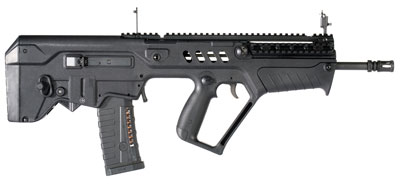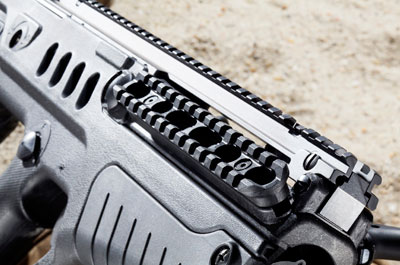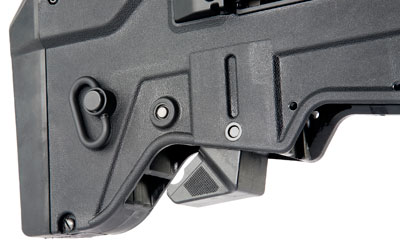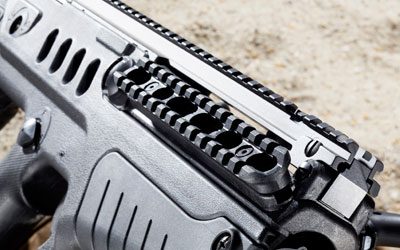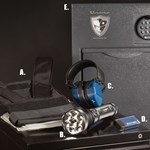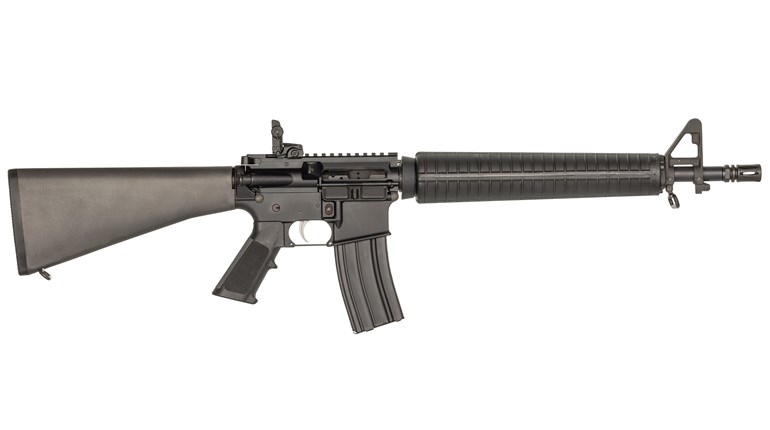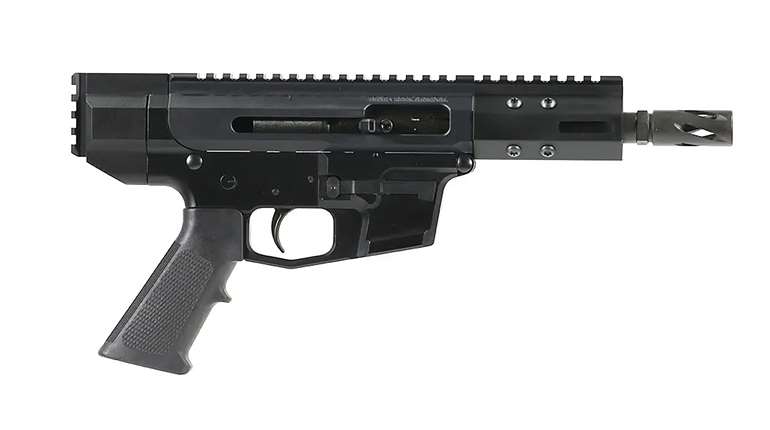
After multiple decades of service abroad, bullpup rifles remain fascinating to many shooters—and equally repulsive to others. Their futuristic looks appeal to about as many people as they turn off. From a practical standpoint, however, bullpups have a less stellar reputation. The British Army's experience with the SA80 has been less than satisfactory, the French recently abandoned the FAMAS and while Luxembourg's 900-man army has not, to my knowledge, registered complaints about its Steyr AUGs, nobody would much care if it did. Therefore, a bullpup service rifle actually praised by the soldiers who must use it would generate much excitement, and the service rifle of the Israel Defense Forces (IDF) has done just that.
Combat Development
In 2001, the IDF began distributing a new rifle to select units for testing, and initial results were quite favorable. Soldier-suggested modifications were made, and by 2009, this bullpup began to be issued IDF-wide, replacing the M16/M4. Designated TAR-21, which stands for Tavor Assault Rifle-21st century, the gas-piston-operated gun is named for Mount Tabor, site of an Israelite victory over the Canaanites chronicled in the Book of Joshua. This is an appropriate name, since the Tavor was designed and built to be a guardian of the modern State of Israel. After proving itself in near-daily counterterrorist combat and larger operations, the Tavor—like many other Israeli firearm designs—has been extensively exported to military units in India, Brazil, Vietnam and Thailand, to name just a few of the countries fielding the 5.56 NATO bullpup in one form or another.
Of course, there was also palpable demand for the Tavor here in the U.S., stoked in large part by the bullpup's appearance in multiple popular video games. But because American law bans importation of full-automatic firearms (and semi-automatic rifles deemed "non-sporting" by BATFE), that demand remained unfulfilled until this year.
Coming to America
Israel Weapons Industries—the Tavor's Ramat HaSharon, Israel-based manufacturer—opened a U.S. subsidiary in Harrisburg, PA, in 2012. When this announcement was made, savvy firearm-industry watchers immediately knew a semi-automatic version of the Tavor would soon be available to American consumers. And so it came to pass, with the Tavor SAR (semi-automatic rifle) making its official debut at the 2013 SHOT Show.
Made in the USA
Anyone who owns a foreign-made, "non-sporting" rifle has probably run into a baffling section of U.S. law, Title 18 USC Section 922(r), which essentially states it is unlawful for anyone to assemble from imported parts any semi-automatic rifle or shotgun into any firearm not suitable for "sporting purposes." In its infallible wisdom, the federal government has determined there are 20 parts to a rifle, and a rifle containing more than 10 imported parts from the government list is entirely imported, even if the remaining nine parts are made domestically and the rifle is assembled in America.
This short section of U.S. law in many ways defines the existence of IWI U.S. The company needed to figure out how to import a "non-sporting" rifle from Israel and turn it into an American-made gun by replacing up to 10 foreign parts with domestically manufactured items. The solution was made possible by the Tavor SAR's extensive use of polymer components (and the fact a magazine counts as three parts). Without listing every part of the bullpup, suffice it to say most of the polymer parts are made in the U.S., as is the trigger, while most of the metal bits come from Israel, including the barreled action. Therefore, the Tavor SAR is, in the most technical manner, an American-made gun.
What does all this mean for shooters? Just about nothing. Thanks to extensive quality control at both IWI U.S. and in Israel, the only consequential difference between the Tavor SAR and the TAR-21 is the lack of a third position on the selector switch of the former. Well, that and the fact it is legal to own the SAR, while the TAR-21 is limited to law enforcement and military use only in the U.S. But there is one thing to remember: You must use a U.S.-made magazine in the Tavor to maintain the legal part count. Since it takes standard AR magazines of all types, however, this is unlikely to be a problem for most people.
Lay of the Land
Because the Tavor SAR is a bullpup, there are a number of differences in its design that play a major role in both its function and the manner in which it is deployed. Starting with the obvious, the Tavor is substantially shorter than an AR, despite having the same barrel length of 16.5 inches. While advantageous for movement in tight quarters, the short space between the muzzle and the front of the fore-end means shooters must make sure their support hand does not wander in front of the flanged handstop to avoid the need for a replacement hand.
Along those lines, the bullpup configuration puts the Tavor's ejection port opposite the shooter's face. You might think this makes firing from the weak shoulder impossible, but thanks to brass deflectors on both sides (ejection can easily be switched to either side), it is merely unpleasant, not painful—you most likely won't get hit in the face with hot spent cases, but they will be flying awfully close.
That said, the ergonomics are superlative once you get used to them, which shouldn't be surprising given the rifle's genesis from soldier feedback. Don't take my word for it—ask former SOF operator Larry Vickers: "Of all the bullpups I have ever handled, the Tavor is the most impressive hands down," he told me. "The gun is well laid out with excellent ergonomics. The fact the 16-inch-barreled version is nearly identical in length to a Heckler & Koch MP5, yet is chambered in 5.56 NATO, makes the Tavor an excellent choice for any confined-space operations."
Inside the Mountain
The placement of the action so far to the rear changes the balance of the gun, with much of the weight toward the butt. I found this made no difference in terms of control, but it feels completely different from an AR and takes a magazine or so to get used to. A bigger adjustment is the location of the centerline (and therefore ambidextrous) magazine well and mag-release lever. With the magazine close to the ribs and the release well behind the pistol grip, swapping mags requires an entirely new manual of arms. While the strong hand maintains a firing grip, the support hand comes back toward the ribs and slaps the release lever. The support hand then comes up directly behind the release lever and shoves the fresh magazine into the mag well.
A reversible, polymer safety selector is located in a convenient spot atop the pistol grip and proved simple to actuate in testing. The trigger, while nowhere near what one would want on a long-range, precision rifle, was much better than expected. Bullpups are notorious for horrific triggers owing to the long trigger linkage required to activate a firing pin located far behind the bang switch. The Tavor's trigger bar is drawn forward on the pull. Some other bullpup designs push the bar back, creating excess flex and leading to a sloppier trigger pull. I found Tavor's pull to be heavy, but smoother than anticipated.
Speaking of heavy, the Tavor SAR's bolt-carrier assembly provides the bulk of the backside-centric weight in the rifle. It is much, much bigger than one found on an AR-15, because, in addition to housing the firing pin, bolt, extractor, ejector and associated retaining pins, it also has a "second story" for the steel piston, recoil spring, recoil-spring-guide tube, guide rod, bolt-rotation-control bar and a polymer buffer behind it all. Basically, the Tavor's engine and transmission are contained in this single assembly, which can be easily removed from the gun for maintenance. Pushing out one captive pin in front of the rubber-coated buttpad allows the buttpad to pivot downward, and the entire bolt-carrier assembly can be taken out of the back of the chassis.
Included QD sling swivels mount at the rear of the chassis and just behind the charging-handle channel. The reversible charging handle is nonreciprocating and can be mounted on the strong-arm side of the rifle—making it easy to operate with the weak hand while maintaining a firing grip. A polymer handguard with a flared handstop envelops the bottom of the fore-end, provides a natural gripping surface. Some shooters (who don't read the excellent manual) may think the button-looking thing in the fore-end is used to remove the handguard, but it is actually a switch. You see, the holding company that owns IWI also owns Israeli sight manufacturer Meprolight, and many IDF soldiers mount Meprolight dot sights on the Tavor's long top rail (IWI U.S. offers an "IDF" version of the Tavor SAR with a Mepro-21 sight included). The company's Mor sight has a built-in laser-aiming module and an included activation cable. Routing that cable inside the Tavor's chassis to the switch enables shooters to toggle the laser from a normal grip. A word of caution here: Only shielded cables should be used in this manner, since unshielded cables will melt from the heat created during shooting. Many Meprolight Mors currently on dealers' shelves do not have shielded cables.
Fortunately, you don't need an optic to have a clear sight picture when firing the Tavor SAR. Built into the aluminum top rail are folding front and rear sights at the proper height for a bullpup's unique position relative to a shooter's eyes. The front sight post is adjustable for windage and elevation, and the irons are easily co-witnessed with dot sights. These are among the best included iron sights I've come across, and when stowed, they are basically invisible.
In addition to the six versions of the Tavor, including 18-inch-barreled models and flat dark earth chassis, IWI U.S. offers conversion kits to 9 mm and 5.45x39 mm.
Taking the Pup to the Park
After getting used to the Tavor's bullpup layout, I found it as easy to shoot as an AR, and perhaps more instinctive, because one must form a tight unit with the compact rifle. Movement with the gun shouldered was easier, and I appreciated its minimal length when suspended from a two-point sling. Accuracy was on par with a factory AR, and no failures were encountered. The Tavor seemed to prefer heavier-weight bullets, which is not surprising given the barrel's 1:7-inch twist rate.
I plan to buy my test sample and shoot it often, because the Tavor SAR is one of the most exciting guns on the market. More importantly, it has a real role to play in any defensive plan. Again, don't take my word for it—Vickers offered this parting thought: "I would encourage anyone to check out this bullpup and give the breed a hard look, as this is the best of the bunch."
Specifications:
Manufacturer: IWI U.S., Inc.; (717) 695-2081
Action Type: Gas-piston-operated, semi-automatic
Caliber: 5.56 NATO
Capacity: 30 rounds
Receiver: Hard-anodized 7075-E6 aluminum with Teflon coating
Barrel: 16.5 inches; chrome-lined, cold-hammer-forged chrome-moly vanadium steel; threaded
Rifling: 6 grooves; 1:7-inch RH twist
Sights: Steel folding; rear peep, windage- and elevation-adjustable tritium front post
Trigger Pull Weight: 11 pounds, 8 ounces
Stock: Injection-molded polymer
Length: 26.125 inches
Weight: 7 pounds, 14 ounces
Accessories: QD sling swivels, cleaning and maintenance kit, sight-adjustment tool, one 30-round polymer magazine, owner's manual, lock
MSRP: $1,999
Shooting Results
| Load | Velocity | Group Size | ||
| Smallest | Largest | Average | ||
| Black Hills 55-grain FMJ | 2,941 | 1.27 | 1.77 | 1.62 |
| DoubleTap 62-grain SS109 FMJ-BT | 2,838 | 1.17 | 1.68 | 1.40 |
| Federal Power-Shok 55-grain FMJ-BT | 2,887 | 1.31 | 1.92 | 1.66 |
Velocity measured in fps at the muzzle for 10 consecutive shots using an Oehler Model 36 chronograph. Temperature: 66 degrees Fahrenheit. Accuracy measured in inches for five consecutive, five-shot groups at 100 yards from a Caldwell Handy rest.
